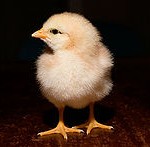Just a Cluck Away from E. coli
When people hear the name E. coli, even a passing familiarity brings about reactions of disgust and fear of food poisoning. This outright hatred of the common bacteria is, perhaps, a bit unwarranted, considering there are many different types of Escherichia coli. Not only are there harmful strains, but there are also many that are harmless to humans and some that are even helpful as well. We actually have our own E. coli that live in our intestines, take some of our nutrients and make essential vitamin K2 for us, which we cannot make for ourselves. Vitamin K is an important factor in blood coagulation. So we have a good relationship with them, unless they are redistributed to the wrong places in our body where they can cause infection, illness and generally wreak havoc. As many as 85% of urinary tract infections (UTI) are caused by E. coli, and most of these infections are thought to be linked to the native strain that lives in our intestines.(1) Now there is a new suspect to the crime, chickens.
A group of scientists from McGill University, led by Amee R. Manges, compared the DNA of common human UTI bacteria to samples of bacterial strains found in beef, pork, and chicken. Strains from beef and pork turned out to be less genetically related to UTI strains than samples collected from chicken, which seem to be very closely related.(2) To add to the intrigue, this is a strain found on the actual animal, and is not connected with contamination from meat production plants.
So, does this mean we have to stop eating chicken? Absolutely not, in fact, in my small family it is an essential staple. Imagine a world with no chicken nuggets! There are many things that the average consumer can do to reduce the chance of E. coli infection. The proper handling and cooking of raw material will adequately kill most of the bacteria. Careful sterilization of the area exposed to any raw meat will usually take care of the rest. 
However, the responsibility should not rest only on the shoulders of consumers. Manufacturers can play a big role in the reduction of disease-causing E. coli. One factor that makes chickens vulnerable to the contagion is their proximity to one another. When their living quarters are too tight, then they share all of their nasty pathogens as well as their food and water. Giving them more space in a cleaner environment would immediately ease the spread of E. coli.
Antibiotics have often been used by livestock owners to kill bacterial infections. This can be effective, but overuse has been proven to produce antibiotic resistant bacteria. The transmission of resistant bacteria to humans has been seriously complicating treatment of infections, even in UTI.
References
- http://www.kcbd.com/story/16942940/e-coli-in-chicken-linked-to-urinary-tract-infections: E. coli in Chicken Linked to Urinary Tract Infections
- http://www.gazettenet.com/2012/02/18/bc-med-utila-national-itop-300-words0326-urinary-tract-infections-linked-to-contaminated-chicken: Urinary tract infections linked to contaminated chicken
| Print article | This entry was posted by Elna Carrasco on March 5, 2012 at 5:32 pm, and is filed under DNA Interactive, G2C Online. Follow any responses to this post through RSS 2.0. You can leave a response or trackback from your own site. |

